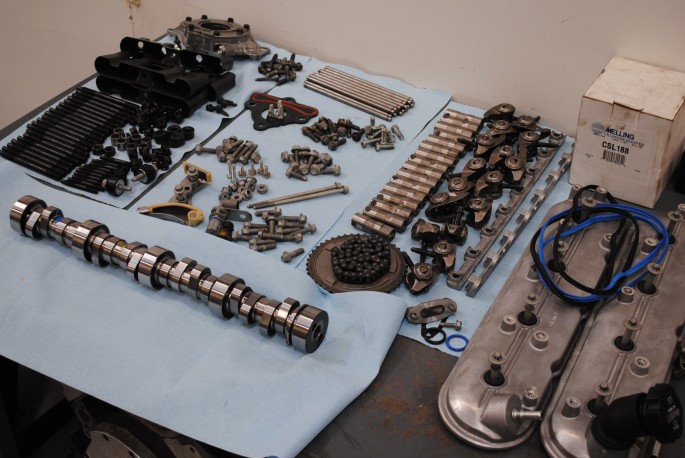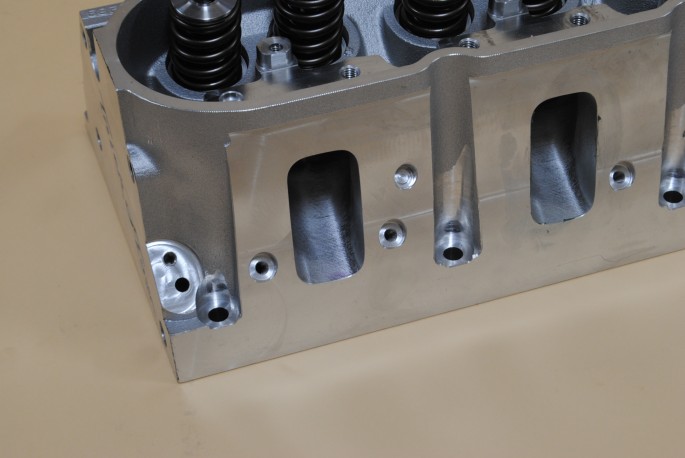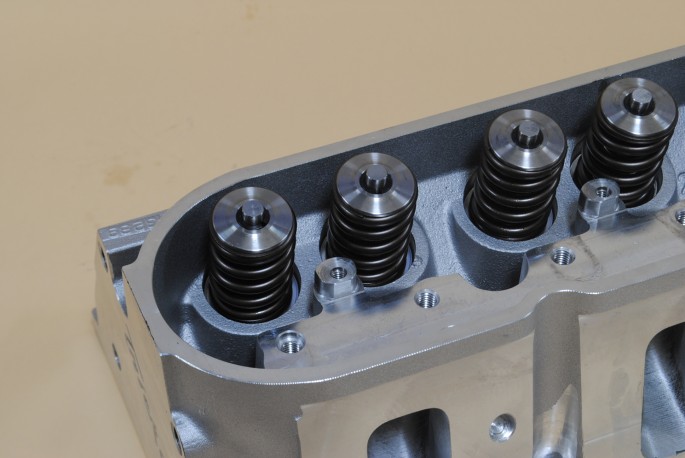(Ok, this guy seems a little TOO excited about the prospect of adding a Vortech supercharger to the stroker LS3, but who can blame him?)
Words & Photos By: Richard Holdener – OnTheDyno.com
Loyal Bangers should remember our Cool G series where we built and dyno tested our 1,000-hp turbo LS combination. CLICK HERE FOR COOL G Part 1 CLICK HERE FOR COOL G Part 2
What started out as a simple, iron-block 5.3L was quickly transformed into a 383 stroker by combining a forged steel crank (4.0-inch stroke) and 6.125-inch rods from Procomp Electronics with a set of JE forged, flat-top pistons. To that short block we added a Crane hydraulic roller cam that offered .624 lift, a 232/240-degree duration split and 113-degree lsa. The forged rotating assembly was topped off with a set of CNC-ported TFS Gen X 215 heads and a Holley Mid Ram induction system. Using a Holley HP management system, the normally aspirated 383 exceeded 500 hp. We then upped the ante by combining a single turbo kit and custom air-to-water intercooler from CXRacing with a massive 76-mm turbo from Precision Turbo. Adding boost to the 383 resulted in a hair over 1,000 hp-thus the name Cool G. Having topped 1,000 hp with a turbo motor, we decided to give the blower guys some love.
As much as we loved the turbo 383, this build up gave us the opportunity to literally expand on the power concept. The 5.3L block used on the turbo 383 was limited in displacement thanks to a maximum bore size of 3.905 inches. This was combined with the 4.0-inch stoker crank to produce the 383 cubic inch displacement. What we needed to increase displacement was increased bore size. Looking around at the possibilities brought us first to the larger 6.0L truck block (LQ4 or LQ9). The 4.030 maximum bore offered by the 6.0L iron truck block put displacement at 408 when combined with the 4.0-inch crank, but we wanted even more. This took our search to the aluminum motors, most notably the 4.065-inch LS3 (L92, LSA, LS9 etc….) blocks. Sure, the LS7 bocks offered 4.125-inch bores, but these were much more expensive and harder to find, so we decided to start our Super Stroker with an LS3. Having run a GMPP LS3 crate motor from Gandrud Chevrolet with great success, we were excited about the prospect of building an LS3 stroker version.

A short block build doesn’t get any easier than grabbing your credit card and ordering up an al-aluminum 417 stroker from Texas Speed and Performance.
When GM introduced the LS3/L92 family, the two major changes (over the previous LS2) included an increase in bore size and rectangular-port heads. The change from the LS1-based cathedral-port heads to the new rectangular-port version netted impressive flow gains. How big were the flow gains offered by the new LS3/L92 heads? In a recent flow test against a set of cathedral-port 317 (6.0L) truck heads, the as-cast rectangular-port LS3 heads offered gains as high as 70 cfm! Just bolting these stock LS3 heads on in place of the cathedral-port heads was worth 40 horsepower. The flow numbers indicate that a set of stock rectangular-port LS3/L92 heads will support 650 hp. In fact, dyno testing a set of stock LS3 heads on a wild (normally aspirated) 468 stroker netted almost 700 hp. Imagine, a set of 700-hp race heads on your stock LS3! The big thing to remember here is that just because the heads offer the potential, doesn’t mean they will make 700 hp on your mild LS3. While an extra 40 hp from an LS3 head upgrade might sound enticing, know that they were designed for big-bore motors. As such, they will not bolt onto your small-bore 4.8L-5.7L and will only just fit on the 4.0-inch bore 6.0L truck and LS2 combinations. Such an LS3 head swap would naturally require the matching rec-port LS3 intake manifold and offset intake rocker arms.
Though we had the LS3 crate motor from Gandrund Chevrolet at our disposal, we decided to take the easy way out and put a call in to Texas Speed and Performance. The stock LS3 would serve as a baseline for this stroker build up. The LS experts at Texas Speed came through with not just an LS3 block, but a complete LS3-based stroker sporting no less than 417 cubic inches. The Texas Speed stroker was built just the way we wanted and was ideally suited to our eventual use of forced induction. The 417 cubic inch displacement was the result of combining a 4.070-inch bore with a 4.0-inch Lunati stroker crank. Stuck in the middle was a set of K1 6.125-inch forged connecting rods and Wiseco forged pistons, not to mention a heck of a lot of precision machining and balancing. The great thing about stroker motors was in addition to the potential for increased peak power (always welcome), strokers offer huge torque gains through the entire rev range. Nothing puts a smile on your face like extra torque. We all brag about the big peak numbers, but it is the extra grunt lower in the rev range that can be enjoyed on a daily basis. How often do you run the motor flat out at redline compared to stomping on the gas for a few seconds to pass some idiot? That surge of torque is addictive, but having a stroker is like getting a fix every time you drive.

In addition to the forged steel Lunati crank and rods, the stroker featured Weisco flat-top pistons that produce a static compression ratio of 10.8:1 with the 69-cc chamber TFS heads and Fel Pro gaskets.
With our short block at the ready, it was time for some power producers, namely the cam, heads and intake. Since the cam and lifters needed to go in before the heads, we completed the short block with a powerful, off-the-shelf Comp hydraulic-roller cam designed specifically for the rectangular-port heads. The 285LRR HR14 from Comp offered .624 lift, a 239/255 duration split and 114-degree lsa. Comp also supplied a set of new short-travel, hydraulic roller lifters. To take full advantage of the lift and rpm potential, the Comp cam was combined with a set of Trick Flow GenX 255 LS3 heads. According to the boys at Trick Flow, the Gen X heads offered 380 cfm from intake ports that measured just 255 cc. This compares to around 315 cfm from 260 cc with the stock LS3 heads, meaning the TFS heads offered significantly more flow AND less port volume. The Trick Flow heads also featured a .650-lift spring package that offered 448 pounds of open pressure or more than enough for our intended engine speed (and eventual boost). The GenX 255 heads were secured using Felp Pro MLS head gaskets and ARP head studs.

Pictured are the majority of the internal parts necessary to assemble the 417 stroker, including the new oil pump, ARP head studs and Comp hydraulic roller lifters.

Factory LS3 motors come with single-bolt cams, but the Comp cam upgrade featured a 3-bolt design. This cam required a dedicated 3-bolt, 4X cam sprocket.

As the name implied, the GenX 255 heads featured 255-cc intake port volumes that offered an amazing 380 cfm. The GenX heads offered nearly 70 cfm more than a stock LS3 head with a smaller intake port volume.

The TFS heads also featured a dual valve spring package with titanium retainers that allowed use of our .624-lift cam.
Now that the long block was sporting the TFS GenX heads and a healthy Comp cam, it was time to complete the stroker assembly. Topping the heads was a set of new factory LS3 offset rockers and hardened 7.70-inch pushrods (from Comp Cams). The TFS heads required longer than stock pushrods (typically 7.40-inches).

The GenX heads featured dedicated rocker stands and required longer-then-stock pushrods. For this stroker, we relied on factory (offset) LS3 rockers.

Naturally our stroker needed a free-flowing, powerful intake manifold. Fast came to the rescue with one of their 102-mm LSXR intakes and matching throttle bodies. Fast also supplied the billet fuel rail and 85-pound injectors.
Feeding the TFS GenX heads was a Fast LSXR 102-mm intake and matching throttle body. We also ordered the matching billet fuel rail to go with the LSXR induction and the motor was fed by a set of Fast 85-pound (LS3 style) injectors. With the top buttoned up, the bottom end was completed using a new HD oil pump, stock windage tray (spaced for stroker clearance) and Holley F-body oil pan. Naturally new Fel Pro seals and gaskets were used during the assembly and the combo was tuned using a Holley HP management system. After the break-in procedure and oil change to Lucas 5W-30 synthetic oil, the normally aspirated 417 stroker pumped out some impressive numbers, peaking at 621 hp at 6,400 rpm and 571 lb-ft of torque at 4,700 rpm. This compares nicely to the 485 hp and 484 lb-ft of torque produced by the LS3 crate motor from Gandrud Chevrolet. Check back with us next time when we ask the big question-Y ask Y, or more specifically why not add a Ysi supercharger to this already impressive stroker?

Tuning the stroker was a Holley HP management system. Maximum power came only after dialing in the air/fuel and timing curves.

After a break-in procedure and oil change to Lucas synthetic, the 417 LS3 stroker produced 621 hp at 6,400 rpm and 571 lb-ft at 4,700 rpm. Torque production exceeded 550 lb-ft from 4,400 rpm to 5,800 rpm.

As a sneak preview, here is what we installed on the stroker for part 2-check back with us very soon to see just how much power this supercharged stroker made.
TUNE IN NEXT WEEK FOR PART II!!!!!!

How do you not love an all-aluminum stroker that pumps out over 620 hp and 570 b-ft of torque? The TS 417 stroker combined with the Comp cam, TFS GenX 255 heads and Fast intake to produce 621 hp and 571 lb-ft of torque. Note that the torque curve exceeded 550 lb-ft from 4,400 rpm to 5,800 rpm, and topped 500 lb-ft from 3,800 rpm to 6,500 rpm.
Sources:
Aeromotive
(913) 647-7300
Aeromotiveinc.com
Comp Cams
(901) 795-2400
www.compcams.com
Gandrud Chevrolet
800-242-2844
[email protected]
Holley/Hooker
270 782-2900 (Tel)
holley.com
Onthedyno.com (coming soon)
Trickflow Specialties
888-841-6556
Trickflow.com
Vortech Superchargers
(805) 247-0226
www.vortechsuperchargers.com
Westech Performance Group
(951) 685-4767




























love the torque “curve” haha… The word Table comes to mind. Teases.
Looking again, needs more cam or more intake? She goes pretty still at 5500… blower should fix that. Blowers fix everything. 🙂
HOW MUCH MOOLAH SPENT?
You guys should of put on of these Hybrid turbos on there instead
https://www.youtube.com/watch?v=V1hEQbGRJ_Q
Other than missing some important information about how square exhaust improved the motor (after all, cathedral heads have a point, whereas LS3 heads are… square).
this really, seriously, interests me. I’ve always thought the 5.3 in my H3 was anemic – but a simple head and crank swap to 383 would be just what the doctor ordered… coming soon to a build thread near you.